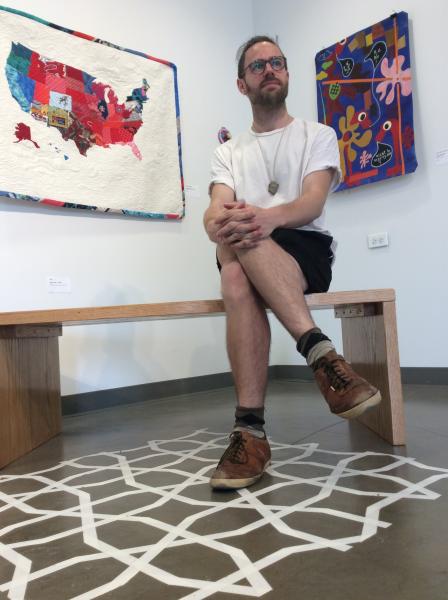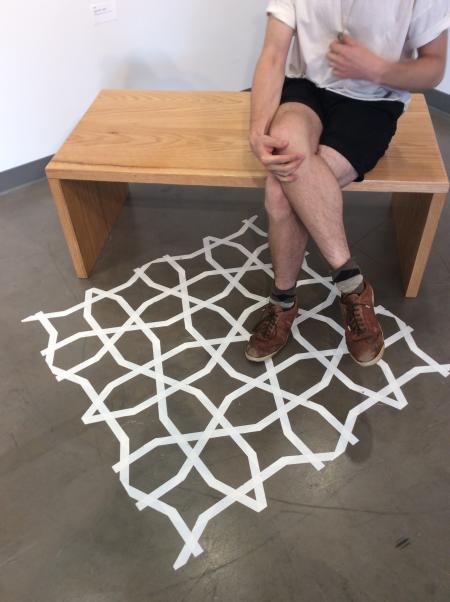JASON BROWN is a visual artist who investigates the ideas of place and space and how they intersect with identity through his 2D work in both public and private spaces. As The Zip Code Kid, he has three pieces in the Evanston Made show, each representing the main zip codes of Northwestern. During a visit to the Evanston Art Center, we were able to sit down and chat more about the ideas behind his work and his unique study of how we are formed by the places we inhabit.
Kelsey Wright is an EAC Arts Administration Intern and graduate student at Northwestern University with the MS in Leadership for Creative Enterprises program. She studied Art and Entrepreneurship at the University of Wisconsin at Madison as an undergraduate, and currently does work with the Art Institute of Chicago.

Kelsey Wright: So can you just start off and talk a little bit about your background and the inspiration for your work?
Jason Brown (The Zip Code Kid): So my background is actually multidisciplinary. I studied International Politics as my major course of study with my minor studies in Place Making and Sculpture, and Urban Studies so I kind of focused my undergrad on looking at different scales of study and scales of identity, which has become the foundation for my artistic approach, as well.
KW: Online, you talk about this intersection of Space, Place, and Time as it influences your work. Can you talk a little bit more about that and how that influences your work currently?
JB (TZCK): So, place, space, and time. These for me are geographic and sociological concepts that I like playing with that we don’t always think about in the day to day but deeply affect how we live our lives. These are things in the planning rooms of urban planning firms of cities and municipalities use to form the buildings and the urban spaces that we dwell in and then those spaces go to form us, or inform how we live in the world. So, if we take some time to slow down and think about these concepts, I think we better form ourselves and the world around us. If we find practices to do that, which is not an easy thing, and a little bit mystical and magical thinking in some ways but I think if we’re thinking more about this relational process of space forming us and us forming place, then we can be better and more informed and intentional actors in whatever places that we are.
KW: There’s a lot of mention about Geocommunetrics throughout your work. What IS Geocommunetrics and what does that mean in the outdoor space?
JB (TZCK): Yeah, so this is where the concepts meet the ground. Geocommunetrics is all of these concepts bundles together for me. This is a ‘porte manteau’ or new word that I made up from placed, spaced community identity calculated imaging. One form of this are the things you see on the floor out here which are these graphic designs that are derived directly from zip codes and the other side are these conversations about place, space, time and community. Really, how we are formed by these spaces that we’ve inhabited in this world, how we kind of take those as layers to how we see the new places that we inhabit and whatever comes from that. If there is a Geocommunetrics method, it’s this act of taking metric-ed space and reimagining it to collide with reality, to put another layer on reality.
KW: So then can you talk about the intersection of Geocommunetrics and the work you’ve done with Evanston?
JB (TZCK): Evanston has been a nice laboratory for my work. It’s also been my home. I live in south Evanston. I’ll have been there for five years this fall. 60202 is my zip code and I’ve done much work with that. What’s been nice is that I’ve been able to experiment with if these forms actually have a place in this world because I’ve been able to do a little bit of craft, a little bit of fine art, and a little bit of theory work, which I love doing all of those things. It’s hard to find myself at home in just one of them. For awhile, I was making pillows and these pillows had these designs on them and people thought ‘Oh, those are just pretty designs. Cool. I want that.’ And others thought ‘Oh, this is derived from my zip code and it represents something. I like that representation. I want that!’ And then there are some larger installations, actual installations, that I’ve been able to do. I did a fence in downtown Evanston and that was fun because it took up space and it was this kind of abstract design but then I had this kind of poetic work that paralleled it to inform people where these colors and where these metrics came from, just to kind of whisper to the observer that there’s something deeper here. And I hope that that’s kind of my allegory for the world, that things can be both beautiful and deep. Inherently, they are both beautiful and complex, and when you recognize complexity, you need to lean in further to ask ‘what’s going on here? And how is it integral to the other complex things in the world.’ Then, I’ve done some other smaller works. I really like doing personal cards or little things that you can hang on your wall and these little momentos or totems to home places that you’ve inhabited in the past that you’ve kind of summoning into your world today, as nostalgic force and identity recognition.
KW: So tell me more about your actual pieces in the Evanston Made show. There are three. Can you tell about the inspiration and intention for those?
JB (TZCK): So yes, there are three and they represent the three zip codes of Evanston, 60201, 60202, and 60203. Those are the major zip codes. There are a few others, but they’re postal and Northwestern. I like when the pieces can take up space that you can also inhabit so I really wanted people to stand on them, and pretend that they’re in that part of Evanston, or, if that’s they’re home space in Evanston, like 60202 for me, I can stand in that space and think ‘Oh cool, I’m in Evanston, but both in my part of Evanston and in this part of Evanston.’ And just to think about these layered veils that we observe the world in. These are on the floor, so less of a veil, but last year I did an installation on the window which is kind of prime for thinking about this as an actual lens into the world but I like this terrestrial plane to recognize that there is a layer on top of it. So there are just these kind of platforms for magical thinking. I did this project in the past that I called Square Foot of Home where I created plaid pieces that were derived from peoples’ zip codes and size of their foot, so they could imaginarily step on these things and summon their home space which was supposedly far away. I liked this idea of recognizing the duality of memory and presence and leaning into that complexity.
KW: How does your work change from a gallery setting to a public setting, since you’ve done some work in both. How does that change your practice or your method or just your thinking when it comes to your work?
JB (TZCK): I think with the pieces that I’ve done here at the Evanston Art Center, I’ve just presumed it to be public space even though its technically not. What’s nice is that it’s curated so there’s already beauty to play off of and juxtapose or play with. In public space, you have to be a little more mindful, and push towards play a bit, I think, which is not always my tendency. I take things pretty seriously, you know I’m playing with these crazy concepts that no one is necessarily going to intuit. So, in public, I like to be a little more colorful or a little more playful in that sense so people can engage it on an additional layer, beyond the layers that I’m packing into it. In a gallery space, people are coming into it with an aesthetic air already in their understanding, thinking ‘I’m coming in with some informed classes’ or whatnot and they can pick it apart on those scales. When I’ve done public installations, people have asked ‘Is this art?’ and I’m like, ‘Well, you tell me’ and there’s an interesting conversation there because when it’s in the gallery, people know it’s art or they presume it’s art. When you do things in public, people start with questions before that- ‘Is this art?’ and you can throw some of that back at them- ‘It is, yes, but also…’
KW: Yeah absolutely. I saw some pictures of you actually installing the work in the Evanston Made show and there were grids involved. Can you talk about your planning for those and how that affects the final product?
JB (TZCK): Yes, so with much of my work, particularly the zip code metric pieces, like 60% of the work is planning, or more. Particularly when I haven’t really done many of the same form so the practice differs every time which keeps me excited and engaged because I have to be in it and on the whole time and I can’t slack from saying ‘I’ve done this before, I know how to do it.’ So, for this installation I really wanted to have them displayed throughout the space, which was my first idea so you can engage with them facing different directions. I also oriented them towards the cardinal point that the zip code was generally in with the benches involved, so 60203 being West, 201 being North, and 202 being South. Then the other planning, I was just laying down grids and figuring out what points were on the grid and then abstracting them from there. So a lot of meticulous work.
KW: I know you mentioned this before but how do you envision or hope that people will interact with your pieces? What do you want people to take away?
JB (TZCK): I mean I don’t imagine that people are going to stand on them and have this mystic, ecstatic experience of being transported to their home space. That sounds GREAT but it’s not going to happen. I think, for now, in this space, because I don’t have some epistle to write to people, that they just experience it as a beautiful addition and difference within the place, because it’s mostly populated by sculpture and 2D works that are on the wall. I think my play with this is just to say ‘Hey, how about a little something different? What if we did something on the floor?’ And then I think people will find these pieces because of their symmetry and their repetition kind of peaceful and calming and I think if that’s something that I can summon within them now then that’s all I need.
KW: So my last question is “What’s next?”
JB (TZCK): I’m working on a few things. I’m doing some small works. I fell in love with doing works on panels because the planning is a little easier on these nice square panels of wood, so I’m doing a few commissioned works and a few playful works with this textile pattern. Conceptually, I’m looking to build out geocommunetrics as an interdisciplinary institute that fosters workshops and classes per say. One of the workshops that I’m developing now is called a collective cartography workshop which I’ve been granted by the City of Evanston Arts Council to bring throughout Evanston. It has nothing to do with zip code art and everything to do with how people envision their home place and what they see as Evanston assets and deficits and tendencies towards or against equity so those are the geographic and sociological leanings that are closer to the heart of geocommunetrics as a method that are very separate my metric-ed art pieces.
For more about Jason Brown, be sure to follow him on Instagram @thezipcodekid, and check out his Geocommunetrics Facebook page. And don’t miss a chance to visit the Evanston Made show at the Evanston Art Center, open through June 30th.
Meet the Artist! Jason Brown aka The Zip Code Kid from Evanston Art Center on Vimeo.


